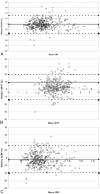Reproducibility of quantitative CT brain perfusion measurements in patients with symptomatic unilateral carotid artery stenosis
- PMID: 17494672
- PMCID: PMC8134348
Reproducibility of quantitative CT brain perfusion measurements in patients with symptomatic unilateral carotid artery stenosis
Abstract
Background and purpose: To establish intraobserver and interobserver variability for regional measurement of CT brain perfusion (CTP) and to determine whether reproducibility can be improved by calculating perfusion ratios.
Materials and methods: CTP images were acquired in 20 patients with unilateral symptomatic carotid artery stenosis (CAS). We manually drew regions of interest (ROIs) in the cortical flow territories of the anterior (ACA), middle (MCA), and posterior (PCA) cerebral arteries and the basal ganglia in each hemisphere; recorded cerebral blood volume (CBV), cerebral blood flow (CBF), and mean transit time (MTT); and calculated ratios of perfusion values between symptomatic and asymptomatic hemisphere. We assessed intraobserver and interobserver variability by performing a Bland-Altman analysis of the relative differences between 2 observations and calculated SDs of relative differences (SDD(rel)) as a measure of reproducibility. We used an F test to assess significance of differences between SDD(rel) of absolute CTP values and CTP ratios, and the Levine test to compare the 4 perfusion territories.
Results: MTT was the most reproducible parameter (SDD(rel) <or= 10%). Intraobserver and interobserver variability were higher for absolute CTP values compared with CTP ratios for CBV (16%-17% versus 11%-16%) and CBF (18% versus 10%-13%) but not for MTT (5%-9%). Reproducibility was best in the MCA territory: SDD(rel) was <or=11% for perfusion ratios of all 3 parameters.
Conclusion: MTT is the most reproducible CTP parameter in patients with unilateral symptomatic CAS. Measurement variability in CBV and CBF can be improved if CTP ratios instead of CTP values are used. The MCA territory shows the least measurement variability.
Figures


Similar articles
-
Changes in cerebral hemodynamics after carotid stenting of symptomatic carotid artery.Eur J Radiol. 2012 Apr;81(4):744-8. doi: 10.1016/j.ejrad.2011.01.042. Epub 2011 Feb 5. Eur J Radiol. 2012. PMID: 21300495 Clinical Trial.
-
Reproducibility of dynamic computed tomography brain perfusion measurements in patients with significant carotid artery stenosis.Acta Radiol. 2009 Mar;50(2):226-32. doi: 10.1080/02841850802616760. Acta Radiol. 2009. PMID: 19096955
-
Validation and absolute quantification of MR perfusion compared with CT perfusion in patients with unilateral cerebral arterial stenosis.Eur J Radiol. 2012 Dec;81(12):4087-93. doi: 10.1016/j.ejrad.2012.07.018. Epub 2012 Aug 23. Eur J Radiol. 2012. PMID: 22921890
-
Changes in cerebral perfusion after revascularization of symptomatic carotid artery stenosis: CT measurement.Radiology. 2007 Nov;245(2):541-8. doi: 10.1148/radiol.2451061493. Epub 2007 Sep 11. Radiology. 2007. PMID: 17848682 Clinical Trial.
-
Selection of arterial input function for postprocessing of cerebral ct perfusion in chronic unilateral high-grade stenosis or occlusion of the carotid or middle cerebral artery.Acad Radiol. 2012 Jan;19(1):8-16. doi: 10.1016/j.acra.2011.09.004. Epub 2011 Nov 3. Acad Radiol. 2012. PMID: 22054803
Cited by
-
Prediction of the mean transit time using machine learning models based on radiomics features from digital subtraction angiography in moyamoya disease or moyamoya syndrome-a development and validation model study.Cardiovasc Diagn Ther. 2023 Oct 31;13(5):879-892. doi: 10.21037/cdt-23-151. Epub 2023 Oct 26. Cardiovasc Diagn Ther. 2023. PMID: 37941836 Free PMC article.
-
Evaluation of CT perfusion in the setting of cerebral ischemia: patterns and pitfalls.AJNR Am J Neuroradiol. 2010 Oct;31(9):1552-63. doi: 10.3174/ajnr.A2026. Epub 2010 Feb 25. AJNR Am J Neuroradiol. 2010. PMID: 20190208 Free PMC article. Review.
-
Automated versus manual post-processing of perfusion-CT data in patients with acute cerebral ischemia: influence on interobserver variability.Neuroradiology. 2009 Jul;51(7):445-51. doi: 10.1007/s00234-009-0516-9. Epub 2009 Mar 10. Neuroradiology. 2009. PMID: 19274457 Free PMC article.
-
Hybrid Surgery for symptomatic chronic internal carotid artery occlusion: a single-center experience.Acta Neurochir (Wien). 2024 Aug 30;166(1):355. doi: 10.1007/s00701-024-06250-4. Acta Neurochir (Wien). 2024. PMID: 39212784
-
Whole-brain CT perfusion and CT angiography assessment of Moyamoya disease before and after surgical revascularization: preliminary study with 256-slice CT.PLoS One. 2013;8(2):e57595. doi: 10.1371/journal.pone.0057595. Epub 2013 Feb 22. PLoS One. 2013. PMID: 23451248 Free PMC article.
References
-
- Klotz E, Konig M. Perfusion measurements of the brain: using dynamic CT for the quantitative assessment of cerebral ischemia in acute stroke. Eur J Radiol 1999;30:170–84 - PubMed
-
- Wintermark M, Reichhart M, Thiran JP, et al. Prognostic accuracy of cerebral blood flow measurement by perfusion computed tomography, at the time of emergency room admission, in acute stroke patients. Ann Neurol 2002;51:417–32 - PubMed
-
- Nabavi DG, LeBlanc LM, Baxter B, et al. Monitoring cerebral perfusion after subarachnoid hemorrhage using CT. Neuroradiol 2001;43:7–16 - PubMed
-
- Jain R, Hoeffner EG, Deveikis JP, et al. Carotid perfusion CT with balloon occlusion and acetazolamide challenge test: feasibility. Radiology 2004;231:906–13 - PubMed
